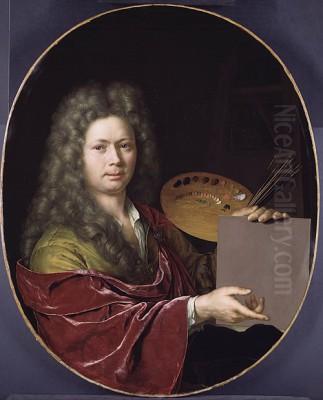
Willem van Mieris stands as a significant figure in the later Dutch Golden Age, a prominent member of the Leiden school of 'fijnschilders' or 'fine painters'. Born into an artistic dynasty, he inherited a tradition of meticulous detail and refined subject matter, carrying the torch of this distinctive style well into the 18th century. His long career produced a body of work encompassing genre scenes, history painting, portraiture, and mythological subjects, all characterized by an exquisite finish and careful composition that appealed greatly to discerning collectors of his time.
Early Life and Artistic Formation in Leiden
Willem van Mieris was born in Leiden, a major center for Dutch art and learning, on June 3, 1662. He was the second son of the highly celebrated painter Frans van Mieris the Elder (1635–1681) and Cunera van de Cock. Growing up in the household of one of Leiden's most famous artists provided Willem with an unparalleled immersion in the world of painting from his earliest years. His primary artistic education came directly from his father, who was renowned for his highly polished genre scenes and portraits.
Frans the Elder was himself a pupil of Gerrit Dou (1613–1675), who in turn had been one of Rembrandt van Rijn's (1606–1669) first pupils in Leiden. Dou is widely credited as the founder of the Leiden 'fijnschilder' tradition, characterized by its enamel-like surfaces, meticulous attention to detail, and often intimate subject matter. Willem, therefore, inherited this artistic lineage directly, learning the demanding techniques required for this style under his father's expert guidance.
Following his father's death in 1681, Willem, then nineteen, continued to develop his skills. He formally entered the professional art world by joining the Leiden Guild of St. Luke in 1685. Membership in the guild was essential for practicing artists, providing a framework for training, quality control, and sales. This marked Willem's official recognition as an independent master painter within the Leiden artistic community.
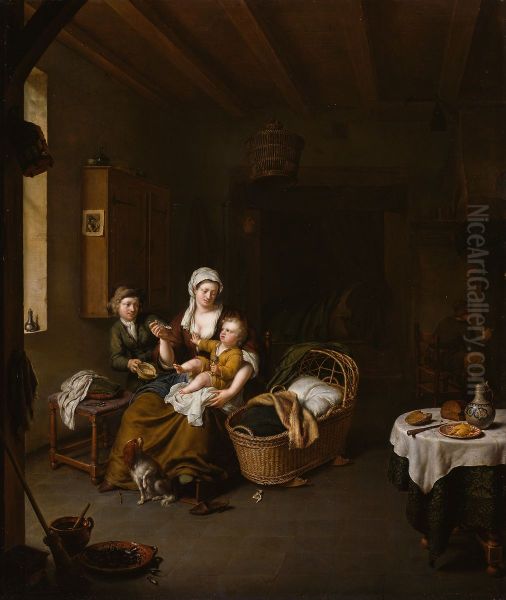
His dedication to his craft is further evidenced by the fact that even at the age of 33, on December 22, 1695, he was registered as studying at Leiden University. While it's not entirely clear what specific studies he pursued, this suggests a continued intellectual curiosity and perhaps a desire to deepen his understanding of subjects relevant to his history paintings, such as classical literature or history.
The Leiden Fijnschilder Tradition
The Leiden 'fijnschilders' represented a distinct and highly successful branch of Dutch Golden Age painting. Originating with Gerrit Dou, the style emphasized craftsmanship, illusionistic detail, and a smooth, polished finish that often concealed visible brushstrokes. These artists typically worked on a small scale, often painting on panel or copper, which enhanced the jewel-like quality of their works.
Subject matter frequently included genre scenes – depictions of everyday life, though often idealized or set in prosperous interiors. Kitchen scenes, scholars in their studies, market stalls, doctors visiting patients, and intimate musical gatherings were common themes. Portraiture was also important, rendered with the same meticulous attention to detail. Later Leiden fijnschilders, including Willem van Mieris, increasingly incorporated historical, mythological, and biblical subjects into their repertoire, often treated with the same detailed refinement as their genre scenes.
Willem van Mieris, along with his father Frans the Elder and his brother Jan van Mieris (1660–1690), became leading exponents of this style in the late 17th and early 18th centuries. Other notable Leiden painters associated with or influenced by this tradition include Gabriel Metsu (1629–1667), though he later moved to Amsterdam, and Dou's pupils like Pieter Cornelisz van Slingelandt (1640–1691) and Godfried Schalcken (1643–1706), who also developed his own distinctive style, particularly known for his candlelit scenes.
The fijnschilder style was immensely popular with collectors, both within the Dutch Republic and internationally. The evident skill, refined subjects, and often high finish appealed to wealthy burghers and aristocratic patrons who appreciated the labor-intensive quality and decorative appeal of these works. Willem van Mieris successfully catered to this market throughout his long career.
Artistic Style and Thematic Range
Willem van Mieris faithfully continued the technical approach of his father and the Leiden school. His paintings are characterized by their extremely fine execution, smooth surfaces, and meticulous rendering of textures – fabrics like silk and velvet, reflective surfaces like metal and glass, and the delicate rendering of flesh tones. He applied paint carefully, often with small brushes, building up thin layers to achieve a polished, almost enameled effect.
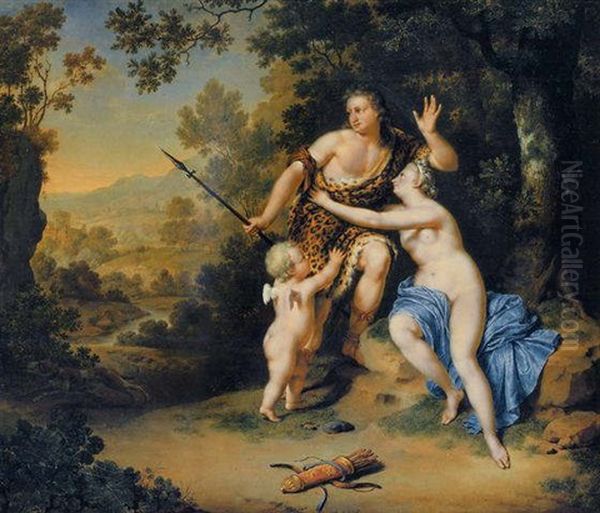
His subject matter was diverse. He produced numerous genre scenes, often set in shop interiors (like grocery stores or poultry shops) or kitchens, frequently viewed through a characteristic stone archway or window frame – a compositional device popularized by Dou. These scenes, while depicting everyday activities, often carry moralizing undertones or showcase the prosperity of the Dutch Republic. Examples include works like The Poultry Shop (Rijksmuseum, Amsterdam).
Willem also excelled in history painting, drawing subjects from classical mythology, ancient history, and the Bible. These works allowed him to depict more dramatic narratives and often included idealized nude or semi-nude figures, particularly female ones. His treatment of these subjects remained highly detailed and polished, sometimes contrasting with the more dynamic or emotionally charged interpretations of these themes by artists like Rembrandt. Works such as Perseus and Andromeda (1691) and The Suicide of Cleopatra exemplify this aspect of his oeuvre.
Mythological scenes featuring gods and goddesses, such as The Judgment of Paris (1705, Private Collection) or Venus and Cupid (RISD Museum), were popular themes. He also painted allegorical and biblical subjects, like Tarquinius and Lucretia (Calouste Gulbenkian Museum, Lisbon), showcasing his ability to handle complex narratives and compositions involving multiple figures.
Portraiture also formed part of his output, though perhaps less central than genre and history painting. When he did paint portraits, they were executed with the same precision and attention to detail, capturing the likeness and status of the sitter through careful rendering of features, clothing, and accessories.
Throughout his work, there is a consistent emphasis on elegance and refinement. Even humble scenes are often imbued with a sense of order and decorum. His lighting is typically clear and carefully controlled, highlighting the intricate details and contributing to the overall polished effect of his paintings.
Key Works and Analysis
Several works stand out as representative of Willem van Mieris's style and thematic concerns:
The Poultry Shop (Rijksmuseum, Amsterdam): This painting is a classic example of his shop scenes. Viewed through a stone archway, a woman bargains with the shopkeeper over poultry. The details are exquisite, from the textures of the birds' feathers to the wicker basket and the gleaming metalware. The composition draws the viewer into the intimate space of the shop, showcasing the artist's skill in rendering surfaces and creating a sense of realism within an idealized framework.
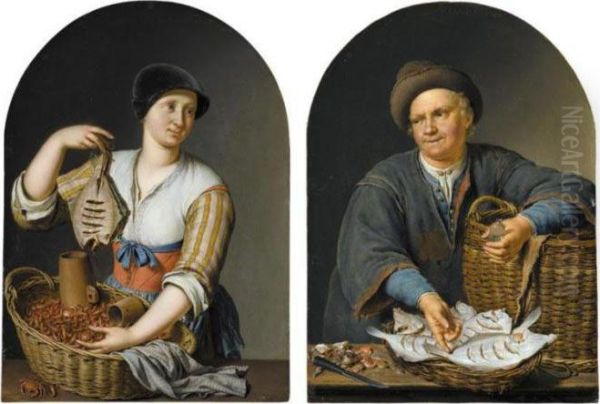
The Happy Mother (1707, Art Institute of Chicago): This intimate genre scene depicts a mother tenderly feeding her child in a well-appointed interior. The painting radiates domestic tranquility and maternal affection. Van Mieris lavishes attention on the textures of the fabrics, the soft skin of the mother and child, and the play of light across the scene. It reflects the fijnschilder interest in quiet, interior moments, rendered with exceptional delicacy.
Perseus and Andromeda (1691): This mythological scene showcases Van Mieris's handling of the nude figure and narrative drama within his refined style. Andromeda is chained to the rock, awaiting the sea monster, while Perseus descends to rescue her. Even amidst the drama, the finish is smooth, and details, like the shells near Andromeda's feet mentioned in some descriptions, are meticulously rendered. The idealization of the figures is typical of his approach to classical subjects.
The Judgment of Paris (1705, Private Collection): Another mythological theme, this work depicts Paris awarding the golden apple to Venus, with Juno and Minerva looking on. Van Mieris presents the goddesses as idealized nudes, showcasing his skill in rendering flesh tones and graceful forms. The landscape setting is rendered with care, providing an elegant backdrop for the classical narrative.
Armida Binding the Sleeping Rinaldo (Private Collection): Based on Tasso's epic poem Jerusalem Delivered, this subject allowed Van Mieris to explore themes of love, enchantment, and the exotic. The depiction of the sleeping hero and the sorceress Armida would have appealed to the taste for romantic and literary themes, rendered with his characteristic precision.
The Drinker (c. 1700-1725): This work likely falls into the category of genre painting, perhaps depicting a tavern scene or a more intimate setting involving alcohol consumption. Such scenes were common in Dutch art, often carrying moralizing messages about temperance or indulgence, though Van Mieris typically treated them with elegance rather than boisterousness. The mention of background wall paintings suggests a detailed interior setting.
The Suicide of Cleopatra: This historical subject, depicting the final moments of the Egyptian queen, allowed Van Mieris to combine historical narrative with the depiction of a reclining female figure, often shown in luxurious surroundings. Again, the emphasis would likely be on the refined execution and the pathos of the scene, rendered with detailed attention to setting and costume.
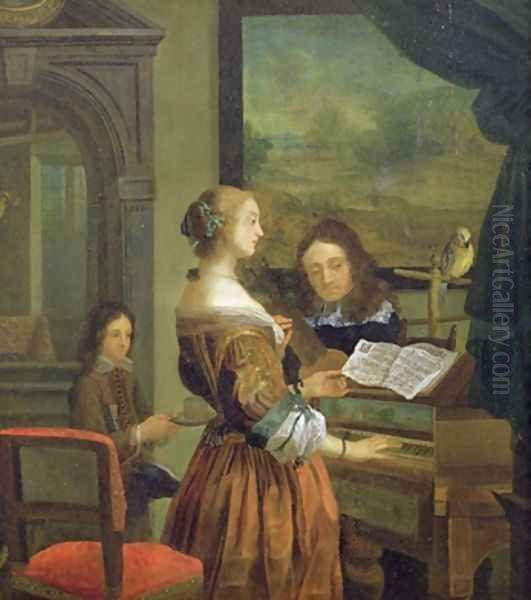
Tarquinius and Lucretia (Calouste Gulbenkian Museum, Lisbon): This dramatic scene from Roman history depicts the moment Tarquinius threatens Lucretia. It showcases Van Mieris's ability to handle historical narrative and convey intense emotion, albeit within the controlled framework of the fijnschilder style. The rich fabrics and detailed setting are characteristic.
These works demonstrate the breadth of Willem van Mieris's subject matter and the consistent application of his meticulous technique, securing his reputation among the leading painters of his generation in Leiden.
Role in the Leiden Art Scene: Academy and Guild
Willem van Mieris was not only a prolific painter but also played an active role in the institutional structures of the Leiden art world. His most significant contribution in this area was the co-founding of the Leiden Tekenacademie (Drawing Academy) around 1694. He established this institution alongside fellow painters Jacob van Toorenvliet (c. 1635–1719) and Carel de Moor (1655–1738).
The establishment of drawing academies was a trend in Europe during this period, aimed at providing more structured training for artists, particularly in drawing from life models and plaster casts, which was considered fundamental for history painting. The Leiden Tekenacademie provided a formal setting for this type of instruction, supplementing the traditional apprenticeship system.
Willem van Mieris served as the director (or one of the directors) of the Tekenacademie for a remarkable period, holding the position until 1736. This long tenure underscores his commitment to artistic education and his respected status within the Leiden artistic community. His leadership would have helped shape the training of the next generation of artists in Leiden, ensuring the continuation of high standards of draftsmanship.
In addition to his role at the academy, Van Mieris remained involved with the Guild of St. Luke. Records indicate he served as 'hoofdman' (headman or dean) of the guild multiple times (e.g., 1697-1698) and later as 'deken' (dean) in 1699. These leadership positions within the guild further highlight his prominence and the esteem in which he was held by his peers. He was clearly a central figure in the organization and promotion of the visual arts in Leiden for several decades.
The Mieris Family Legacy
Willem van Mieris was part of a veritable artistic dynasty that spanned three generations, significantly contributing to the reputation of the Leiden school.
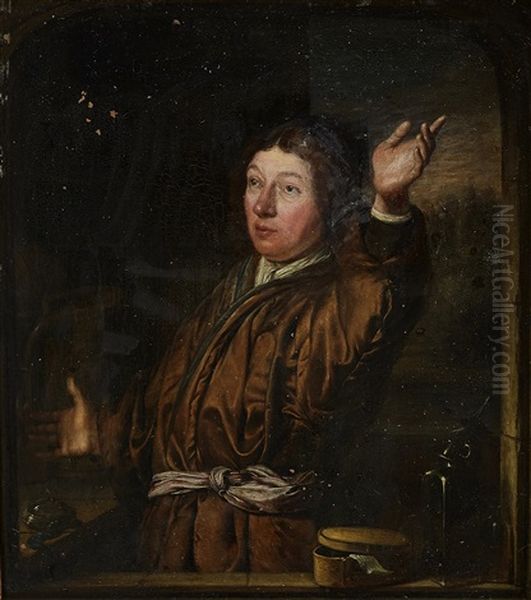
Frans van Mieris the Elder (1635–1681): The patriarch of the dynasty, Frans the Elder, was one of the most successful and highly paid Dutch painters of his time. His exquisite genre scenes, characterized by their fine detail, subtle lighting, and often amorous themes, were sought after by elite collectors across Europe, including Cosimo III de' Medici, Grand Duke of Tuscany. Willem inherited not only his father's technique but also his reputation and access to patronage networks.
Jan van Mieris (1660–1690): Willem's older brother, Jan, was also a painter trained by their father. He specialized in genre scenes and portraits, working in a style very similar to Frans the Elder. Jan sought his fortune abroad, traveling to Florence and Rome. Unfortunately, his promising career was cut short by his early death in Rome in 1690.
Willem van Mieris (1662–1747): The subject of this article, Willem successfully carried on the family tradition for over five decades after his father's death. While some critics argue his work lacked the subtle spark of his father's best paintings, he maintained an exceptionally high level of technical skill and enjoyed considerable success throughout his long career.
Frans van Mieris the Younger (1689–1763): Willem's son, Frans the Younger, represented the third generation of painters in the family. He was trained by his father and worked in the established family style, producing genre scenes and portraits. However, art historians generally consider his work to be less accomplished than that of his father and grandfather. Frans the Younger was also an antiquarian and published works on Leiden history and charters.
This family legacy cemented the Mieris name as synonymous with the Leiden fijnschilder tradition. Their collective output represents a significant contribution to Dutch art history, particularly in the meticulous rendering of genre and history subjects.
Patronage, Reputation, and Anecdotes
Willem van Mieris enjoyed significant patronage throughout his career, attracting wealthy collectors who appreciated the refinement and technical brilliance of his work. His paintings commanded high prices, reflecting the continued demand for the fijnschilder style among the Dutch elite and international connoisseurs.
Among his known patrons were prominent Leiden citizens like Pieter de La Court van der Voort (1664–1739), a wealthy cloth merchant and noted horticulturalist who assembled a significant art collection. Another collector associated with Willem was Cornelis Elzinga. An anecdote relates that Elzinga acquired a painting by Frans van Mieris the Elder but cataloged it as a work by Willem, perhaps indicating the high regard in which Willem was held, or possibly confusion arising from the similarity in styles. Isaac Gerard and Cornelius van der Vuren were also noted collectors of his work.
While perhaps not reaching the stratospheric prices of his father's peak, Willem's work was certainly valued. His reputation extended beyond the Dutch Republic, and his paintings entered collections across Europe. The mention of James II in the source material might refer to the general appreciation of Dutch fijnschilders by European aristocracy, including British collectors, rather than specific direct patronage by the monarch himself, though such connections were not uncommon for highly regarded Dutch artists.
Life was not without its difficulties, however. A documented incident from 1674 (though this date seems early, possibly referring to his father or a misdated event concerning Willem later) mentions a dispute with an innkeeper over failure to deliver a painting on time, allegedly due to drunkenness. While isolated anecdotes should be treated with caution, they offer glimpses into the human side of the artist.
More significantly, Willem's artistic career eventually came to an end due to failing health. In his later years, his eyesight deteriorated, reportedly leading to blindness or near-blindness in one eye, which forced him to cease painting around 1736, the same year he stepped down from his directorship at the Tekenacademie. This marked the end of a long and productive artistic life.
Willem van Mieris died in Leiden on January 26, 1747, at the advanced age of 84. He was buried in the Pieterskerk, a prominent church in Leiden, a final testament to his standing in the city.
Later Influence and Collections
Willem van Mieris's influence extended into the 18th century. His adherence to the detailed fijnschilder style resonated with Rococo sensibilities that valued refinement and elegance. His works continued to be collected and admired long after his death, seen as exemplars of meticulous Dutch craftsmanship. He, along with contemporaries like Adriaen van der Werff (1659–1722) in Rotterdam, represented the continuation of this highly finished style, contrasting with broader, more painterly trends elsewhere in European art.
Today, Willem van Mieris's paintings are held in major museums and collections around the world, confirming his historical importance. Significant holdings can be found at:
Rijksmuseum, Amsterdam: Holds key works like The Poultry Shop.
Mauritshuis, The Hague: Houses several examples of his work, fittingly alongside paintings by his father and Gerrit Dou.
Museum De Lakenhal, Leiden: The primary museum in his hometown, holding works relevant to the Leiden school.
The National Gallery, London: Includes examples of his genre and mythological paintings.
The Wallace Collection, London: Known for its strong collection of Dutch fine painting.
The Art Institute of Chicago: Home to The Happy Mother.
The Getty Museum, Los Angeles: Possesses works demonstrating his technical skill.
Calouste Gulbenkian Museum, Lisbon: Holds Tarquinius and Lucretia.
Royal Museums of Fine Arts of Belgium, Brussels: Includes his work in their collection.
Harvard Art Museums, Cambridge, MA: Represents his work within their collections.
Rhode Island School of Design (RISD) Museum, Providence, RI: Holds Venus and Cupid.
Numerous other public and private collections across Europe and North America.
The presence of his works in these prestigious institutions allows contemporary audiences to appreciate the skill and artistry of this Leiden master.
Conclusion: An Enduring Legacy of Refinement
Willem van Mieris occupies a crucial position in the narrative of Dutch art, particularly as a leading figure in the Leiden fijnschilder tradition during its later phase. Inheriting a rich artistic legacy from his father, Frans van Mieris the Elder, and the school's founder, Gerrit Dou, Willem meticulously upheld the standards of fine painting for over half a century. His work is characterized by its exquisite detail, smooth finish, carefully controlled lighting, and often elegant subject matter, ranging from intimate genre scenes to complex historical and mythological narratives.
As a co-founder and long-serving director of the Leiden Tekenacademie, he played a vital role in artistic education, shaping the skills of younger artists. His involvement in the Guild of St. Luke further cemented his status as a central figure in Leiden's artistic community. While sometimes living in the shadow of his more famous father, Willem van Mieris forged his own successful career, earning the respect of peers and the admiration of prominent collectors both domestically and internationally. His paintings remain captivating examples of the technical virtuosity and refined aesthetic that defined the Leiden school, securing his enduring legacy within the broader history of Dutch Golden Age art.